| Columns Retired Columns & Blogs |
How can this product be superb? Figure 9 shows that the THD is around 0.1 percent. This is unacceptably high, almost tube preamp territory. The THD number should be at least 10-100 times smaller.
I measured the Ayre Acoustics QX-5 Twenty with my Audio Precision SYS2722 system (see the January 2008 "As We See It"), using both the Audio Precision's optical and electrical digital outputs, USB data sourced from my MacBook Pro running on battery power with Pure Music 3.0 playing WAV and AIFF test-tone files, and via Ethernet with Roon 1.3 playing the same files. Apple's USB Prober utility identified the Ayre as "Ayre USB Interface" from "Ayre Acoustics," and the serial number as "Streamlength(tm)." The QX-5's USB port operated in the optimal isochronous asynchronous mode. Apple's AudioMIDI utility revealed that, via USB, the Ayre accepted 24-bit integer data. The optical inputs locked to datastreams with sample rates up to 96kHz, the AES/EBU and S/PDIF inputs to streams of up to 192kHz.
In DAC mode, or in variable mode with its volume control set to "100," the Ayre's maximum output level at 1kHz was 4.47V from the balanced output jacks, 2.23V from the unbalanced jacks, 8.96V from the balanced headphone jacks, and 4.5V from the single-ended headphone jacks. All outputs preserved absolute polarity; ie, were non-inverting. The output impedance was a low 153 ohms from 20Hz to 20kHz from the unbalanced line-output jacks, this doubling as expected from the balanced jacks, to 305 ohms. From the single-ended headphone jacks the output impedance was a super-low 3 ohms, this doubling to 6 ohms from the balanced headphone jacks.
The QX-5's impulse responses with 44.1kHz data with its Music (fig.1) and Measure (fig.2) reconstruction filters reveal that both filters are minimum-phase types, but that Music has very little post-sample ringing. The Music filter appears to be identical to the filter used in Ayre's Codex D/A headphone amplifier and QB-9DSD D/A processor. The red and magenta traces in fig.3 show that the Music filter has a slow rolloff above the audioband (footnote 1), with the result that the image at 25kHz of a full-scale 19.1kHz tone (cyan and blue traces) is suppressed by just 10dB, and that higher-order images are folded down into the audioband, though the latter lie at or below –70dB. Again, the behavior of this filter is identical to that of the Codex.
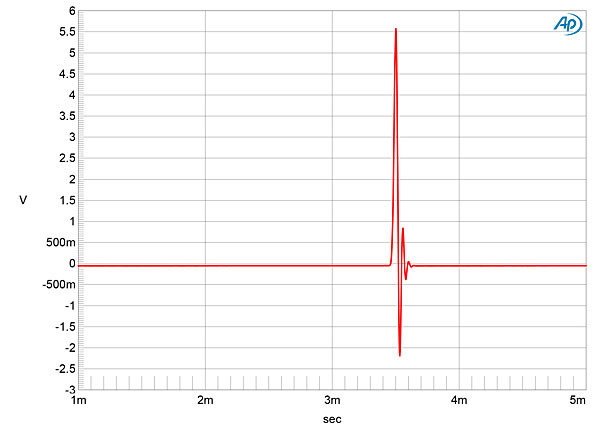
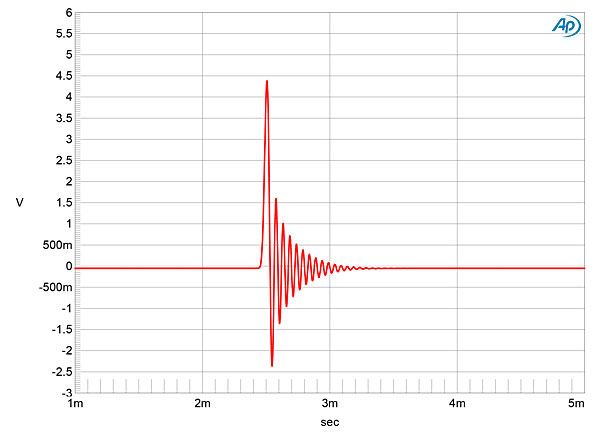
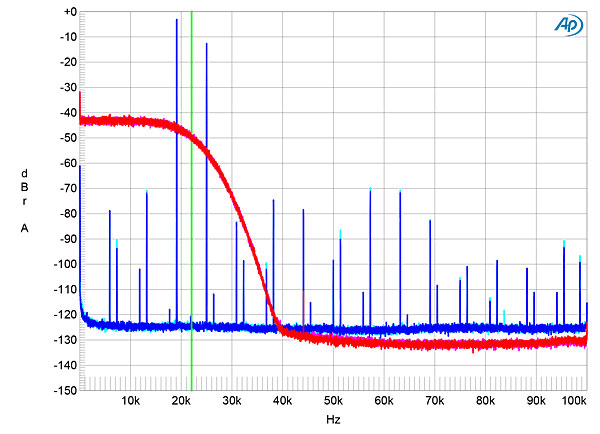
With the filter set to Measure, the ultrasonic rolloff (fig.4, red and magenta traces) is more conventional, in that the output plunges above 20kHz, though it hasn't quite reached full attenuation by half the sample rate (vertical green line). This time, the image at 25kHz is suppressed by almost 100dB, and no audioband spuriae are visible. The second, third, fourth, and fifth harmonics of the 19.1kHz tone can be seen, though the highest-level of these, the third at 57.3kHz, is still 66dB down from full level (0.05%). This is impressive circuit linearity, given the QX-5's lack of loop negative feedback.

Fig.5 shows the QX-5's frequency response with the Music filter, taken with spot tones at sample rates of 44.1, 96, 192, and 384kHz. The slow rolloff with 44.1kHz data seen in fig.3 results in an output down by 1dB at 13kHz and by 3dB at 20kHz, which is the same as I found with Ayre's Codex. The slow rolloff is again seen at the higher sample rates in this graph, but the audioband response is basically flat. Channel separation (not shown) was superb, at >120dB below 2kHz, while the QX-5's noise floor was free from power-supply–related spuriae, other than a touch of 180Hz at a vanishingly low –120dB in the left channel, and even lower in the right.
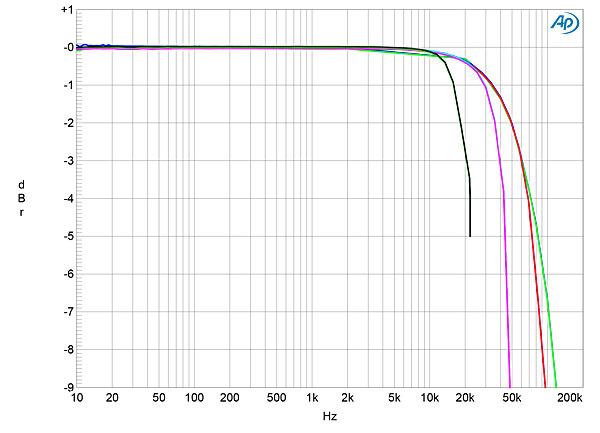
Increasing the depth of a dithered 1kHz tone at –90dBFS from 16 to 24 bits dropped the noise floor by 20dB (fig.6), suggesting resolution of almost 20 bits. The waveform of an undithered tone at exactly –90.31dBFS was symmetrical (fig.7), with the three DC voltages described by the data very well defined. With undithered 24-bit data, the QX-5 output a clean sinewave (fig.8), despite the very low signal level.
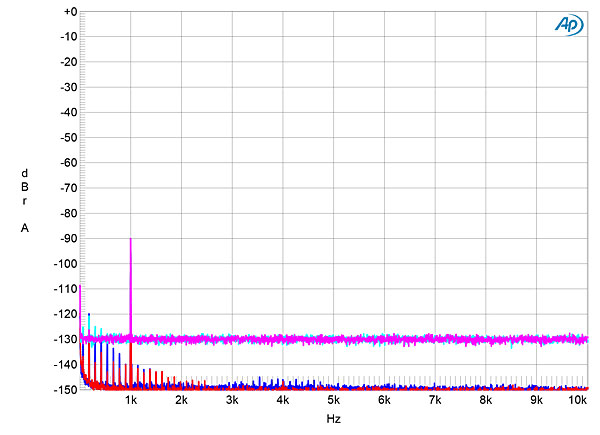
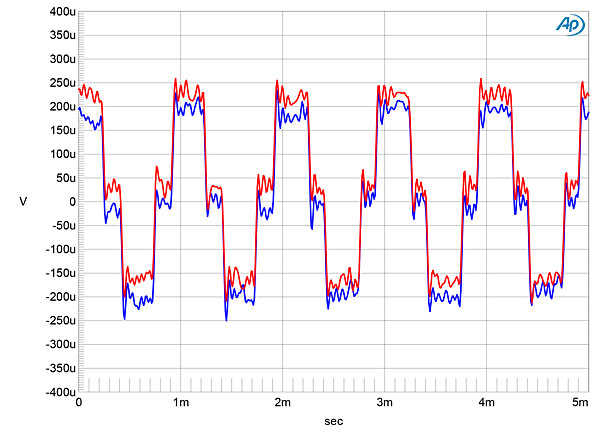
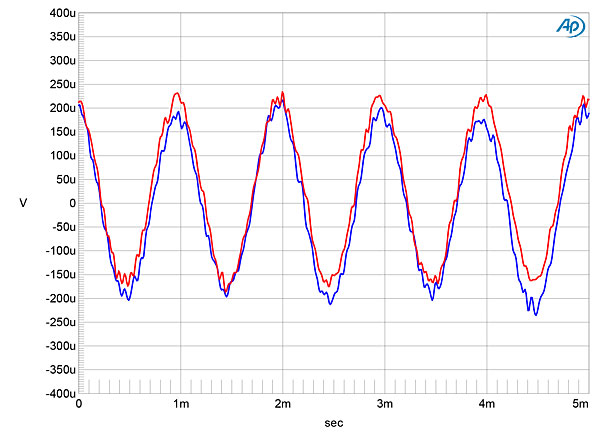
As shown in fig.4 and confirmed in fig.9, the Ayre has relatively high levels of distortion present in its output, though again, the highest-level harmonic, the third, is still low in absolute terms. Commendably, the distortion didn't rise when the very high 100k ohm load was replaced with the punishing 600 ohm load. The distortion signature also remained constant at different signal levels, indicating that the circuit's transfer function isn't modulated by the signal. This lack of modulation is something that I suspect correlates with an ease in a product's sound quality.
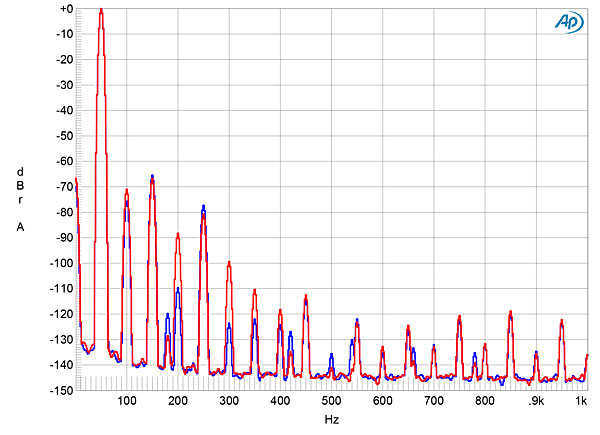
When tested for intermodulation with my usual equal mix of high-level 19 and 20kHz tones, the QX-5's behavior depended on which filter had been selected. With the Measure filter (fig.10) intermodulation was respectably low, given the analog circuitry's lack of loop negative feedback; the 1kHz difference product lay at –79dB (0.01%). With the Music filter the difference product lay at the same level, though the picture is confused by the presence of many aliasing products (fig.11). Fortunately, music almost never has high energy at the top of the audioband.
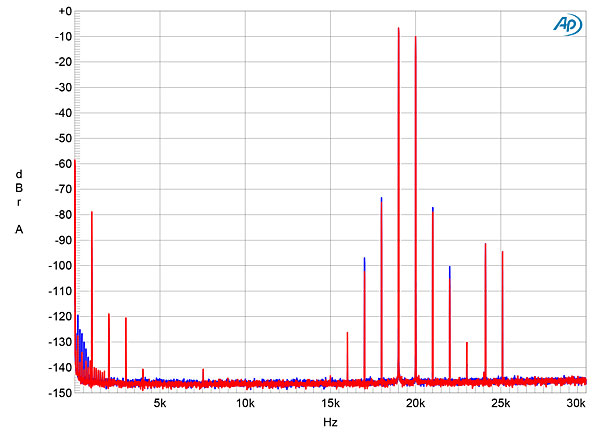
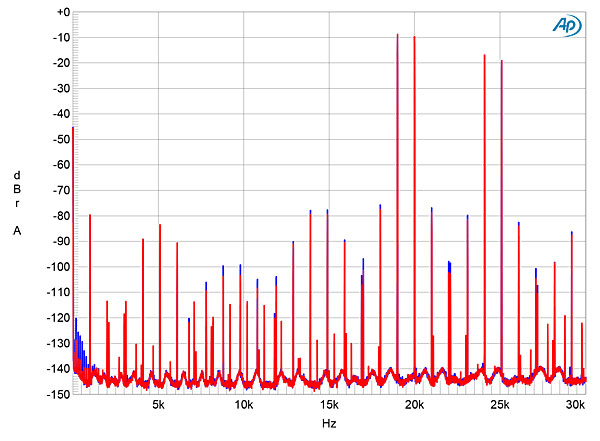
The QX-5 offered superb rejection of word-clock jitter, with the odd-order harmonics of the undithered low-frequency, LSB-level squarewave in the 16-bit Miller-Dunne J-Test signal all lying at the correct levels and with no sideband pairs visible (fig.12). This graph was taken with AES/EBU data; with Ethernet and USB data, neither of which should be prone to jitter interference, the picture was identical except for a slight broadening at the base of the spectral spike that represents the high-level tone at one-quarter the sample rate with USB data (fig.13). This broadening, which will be due to very low-frequency random jitter, should have no audible consequences, but it should be noted that I did find the QX-5 to sound slightly more authoritative with AES/EBU and Ethernet data than with USB data. With 24-bit J-Test data (fig.14), there were no spuriae to be seen!
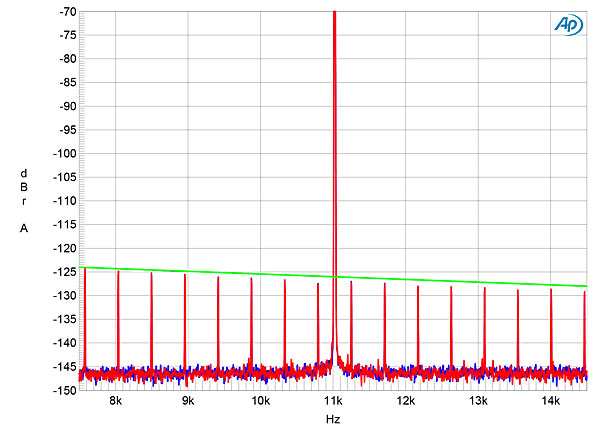
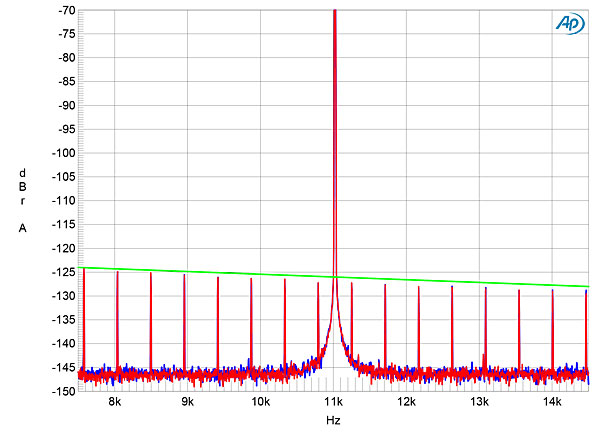
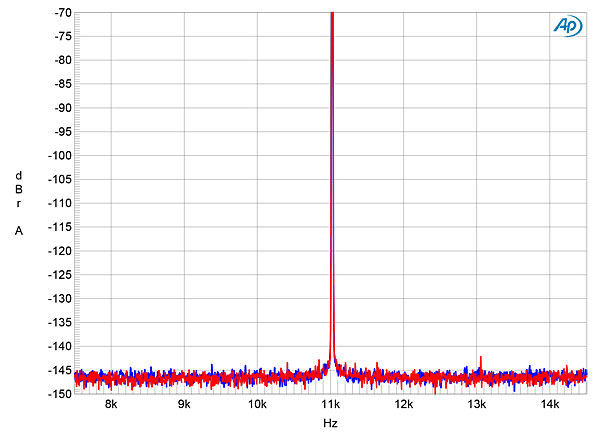
Overall, Ayre's QX-5 Twenty digital hub offers superb measured performance.—John Atkinson

correct me if I'm wrong guys,but if a recording is,at any stage, digital,then it is not analog. In order to be analog a recording must be 100% analog, from beginning to end. If the master is a digital file,then cutting a vinyl disc from it is a digital recording on vinyl. Defeats the whole purpose, I would think. Not that pure analog would necessarily sound better although in theory it could. Maybe there's something elusive that's captured by an analog recording that's lost as soon as it's converted, at any point, to digital.Something that we don't know how to specify or measure because we don't know what it is.

Geez, I just had a little trip down Memory Lane with those Thiel CS1s.
Which -- prompted me to have a look at Mr. Atkinson's history with Amplifiers.
Hmm, what happened to that Krell Amp you brought back from England?
I discovered Mono Amps to be the Ideal as seems the case with ya'll. I'm now going further down that path by thinking that Active loudspeakers are the natural ideal.
Do I see plenty of Ayre gear in your System Photos ?
I suppose we all prefer what works well and kinda stay with it, is Ayre a worthy Brand to build with and stay put? I'm getting that idea from Stereophile writers.
I hope you review those new Schiit Mono Amps & matching Pre-amp.
It's fascinating to read that the MBL Amp is Class D
Tony safe in Michigan

Hmm, what happened to that Krell Amp you brought back from England?
I still have it and occasionally use it. Recently I took it to John DeVore's place to use for a screening of the movie "Forbidden Planet," which was where Dan D'Agostino got the name "Krell" from.
John Atkinson
Editor, Stereophile

John Atkinson wrote
Overall, Ayre's QX-5 Twenty digital hub offers superb measured performance.
and I have to say that it is really difficult for me to agree with his statement. I understand that there is to be a kind of 'political correctness' in reviewers writing, however the measurements of non-linear distortions and filter mirrors and aliases say the opposite.

I have to agree. This DAC measures shockingly poor, and then at this extraordinary price! "Extortion" is really the right word here.
Someone once said that two segments of hi-fi products are extremely poorly made: The exceptionally cheap products, and the exceptionally expensive products. Ayre seems to be an example of this. But this is probably one of the reasons why digital haters prefer Ayre to so many other products, because they are as imperfect as turntables and cartridges - they muddy up the sound, distorts and twists it so it finally sounds as poor as analogue. And I'm saying this as someone who collected vinyl records for 15 years.
Compare the Ayre DAC to the €250 Topping D50s (yes, only €250), which measures infinitely much better. The highest harmonic in that DAC is at -120, compared to -65 dB in the Ayre. And the filters in the Ayre are terrible as well!
I suspect that the roll-off with 44.1 kHz data has conciously been made that way to "show" listeners that the format is poor and that hi-res sounds better - which it doesn't with a competent DAC (there will be no audible difference).
And there are many, many other cheaper products that measure almost as well as the Topping. The Odac, the SMSL SU-8 or the Cambridge Audio DacMagic are just three examples. Granted, not all of these were available at the time when the Ayre came out, but there were PLENTY of other DACs that were much better made. And it's honestly sad that this product is being celebrated so much - even by John Atkinson, who sees all these artefacts.

@JA
In the measurements section of this review you mention that
"Apple's AudioMIDI utility revealed that, via USB, the Ayre accepted 24-bit integer data. The optical inputs locked to datastreams with sample rates up to 96kHz, the AES/EBU and S/PDIF inputs to streams of up to 192kHz."
My question is if this seems strange or not given the fact that the DAC Chip is a 32bit device? Is there something in the connectivity chain that would prevent your PC from seeing it as a 32bit device or is there something that Ayre did during the design process that would prevent an End User from "seeing" the fact that the DAC Chip was a 32bit device?
I'm thinking along the line of wanting to use JRiver's 64bit software VOL control. If the Ayre could accept a 32bit feed from some external source that had VOL control capabilities then one could put the Ayre in DAC Mode and bypass the sub-optimal internal VOL control while at the same time maintaining 24bits worth of resolution for a long as possible (ie..maybe -60dbfs) in a DAC Direct to AMP configuration.
On the other hand, if for some reason the QX5 does only accept 24bit Data then I'm left scratching my head as to why they bothered with a 32bit DAC in the first place.
Thanks

if for some reason the QX5 does only accept 24bit Data then I'm left scratching my head as to why they bothered with a 32bit DAC in the first place.
I'll put to one side whether or not the QX-5 accepts 24- or 32-bit data via its USB port. (I don't have a way of examining the behavior of its Ethernet connection.) But the reason for having a DAC chip that will decode 32-bit data is that as soon as you operate on the data before they are presented to the chip, you will increase the bit depth. For example, if your volume control works with 24-bit coefficients, it will output 48-bit data with 24-bit audio. It is optimal to reduce the bit depth as little as possible, even when redithering as you do so. So in theory, reducing 48 bits to 32 bits is better than reducing it to 24 bits.
John Atkinson
Editor, Stereophile